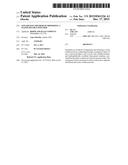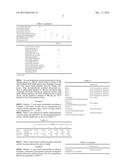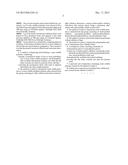Patent application title: NONAQUEOUS METHOD OF DISPERSING A WATER SOLUBLE POLYMER
Inventors:
Anne Oberlin (Antibes, FR)
IPC8 Class: AC08J307FI
USPC Class:
524733
Class name: Preparation of intentional or desired composition by formation of a solid polymer (sp) or sicp in presence of a designated nonreactant material (dnrm) other than solely water, hydrocarbon, silicon dioxide, glass, titanium dioxide or elemental carbon, composition thereof; or process of treating or composition thereof carbohydrate or derivative as dnrm cellulose or derivative, e.g., cotton, paper pulp, etc.
Publication date: 2015-12-17
Patent application number: 20150361226
Abstract:
Described are methods of dispersing and hydrating a water soluble
polymer, comprising forming a nonaqueous slurry of one or more
polyethers, one or more water soluble polymer, and hydrophobically
modified ethoxylated urethane, provided that the slurry contains less
than five percent water. The nonaqueous slurry can be put in contact with
water to disperse and hydrate the water soluble polymer.Claims:
1. A method of dispersing and hydrating a water soluble polymer,
comprising: forming a nonaqueous slurry of one or more polyethers, one or
more water soluble polymers, and hydrophobically modified ethoxylated
urethane, provided that the slurry contains less than five percent water;
and then contacting the nonaqueous slurry with water to disperse and
hydrate the water soluble polymer.
2. The method of claim 1, wherein the water soluble polymer is a water soluble modified cellulose ether selected from the group consisting of: alkyl cellulose derivatives, hydroxyalkyl cellulose derivatives, cationic hydroxyalkyl cellulose derivatives (the cationic specie being a quaternary alkyl amine) and carboxylalkyl cellulose derivatives.
3. The method of claim 1, wherein the water soluble polymer is selected from the group consisting of: hydroxyethyl cellulose, cationically-modified hydroxyethylcellulose, hydroxypropylmethylcellulose, and polyethylene oxide.
4. The method of claim 1, wherein the method is performed without addition of heat.
5. The method of claim 1, wherein the polypropylene glycol is Tripropylene Glycol Methyl Ether.
6. A nonaqueous slurry consisting essentially of: polypropylene glycol or polyethylene glycol, at least one of hydroxyethyl cellulose, cationically-modified hydroxyethylcellulose, hydroxypropylmethylcellulose, and polyethylene oxide, and hydrophobically modified ethoxylated urethane, provided that the slurry contains less than five percent water.
7. A personal care composition containing water soluble polymer, formed by the method of claim 1.
8. A fabric care composition containing water soluble polymer, formed by the method of claim 1.
Description:
CROSS-REFERENCE TO RELATED APPLICATION(S)
[0001] This application claims priority from U.S. Provisional Patent Application No. 61/714,369, filed Oct. 16, 2012, which is incorporated herein by reference in its entirety.
FIELD
[0002] The present invention relates to methods and compositions for dispersion of water soluble polymers.
BACKGROUND
[0003] Many water soluble polymers (cellulose, cellulose derivatives, gums, and the like) are typically sold in solid, dry, form, and hence powder handling and processing properties are extremely important. For example, a low dust content is desirable. Also, the ability of the dry powder to be poured from a container or receptacle is described as flowability. Flowability is affected by particle shape and size distribution, and resulting bulk density. Bulk density is the mass of powdered solid material per unit of volume occupied. Acceptable flowability generally depends upon relatively high bulk density and relatively low angle of repose. The angle of repose is the maximum angle between the slope of a conical discharged pile of powder and the surface it rests upon, a lower angle representing a more widely spread pile.
[0004] As part of using the water soluble polymer in its various applications, the water soluble polymer must be dissolved. Dissolution is frequently described as a process with two overlapping phenomena, dispersion and hydration. Dispersion refers to spreading of particles or groups of polymer chains throughout the solution. Hydration refers to loosening of the polymer chains and expansion of their hydrodynamic volume (and corresponding viscosity buildup). If dispersion is poor, or if hydration outpaces dispersion, hydrated polymer can swell and isolate relatively dry, non-hydrated polymer from the solution, forming lumps. Desirable dispersion and hydration are normally characterized by little to no lump formation and a rapid viscosity build up over time, respectively.
[0005] Accordingly, there is a need in the industry to reduce the foregoing problems (dust, variable flow, inconsistent dispersion, or undesirable rate of hydration) in order to simplify formulation of products incorporating water soluble polymers.
DETAILED DESCRIPTION
[0006] In one embodiment, the present invention provides a method of dispersing and/or hydrating a water soluble polymer, comprising forming a nonaqueous slurry of one or more polyethers, one or more water soluble polymers, and hydrophobically modified ethoxylated urethane, provided that the slurry contains less than five percent water. The nonaqueous slurry can be put in contact with water to disperse and hydrate the water soluble polymer.
[0007] The term "polyether" means an oxygenated solvent or polyol. It is contemplated that the polyether may include methyl ether and/or propyl ether units in its composition, and/or be a polyglycol copolymer of ethylene oxide and propylene oxide.
[0008] In one embodiment, the water soluble polymer is at least one water-soluble, film-forming natural and synthetic polymers including alkylcellulose ethers, hydroxyalkyl cellulose ethers and hydroxyalkyl alkylcellulose ethers, including methylcellulose; hydroxypropyl methylcellulose (HPMC); hydroxyethyl methylcellulose (HEMC); hydroxyethyl cellulose (HEC); hydroxypropyl hydroxyethylcellulose (HPHEC) and hydroxypropylcellulose (HPC), water-soluble, high molecule weight polymers of ethylene oxide, preferably of about 20,000 molecular weight or higher; natural products such as guar gum, xanthan gum and water-soluble thickening agents. Preferably, the water soluble polymer is a water soluble modified cellulose ether selected from the group consisting of: alkyl cellulose derivatives, hydroxyalkyl cellulose derivatives, cationic hydroxyalkyl cellulose derivatives (the cationic specie being a quaternary alkyl amine) and carboxylalkyl cellulose derivatives. In one embodiment, the water soluble modified cellulose ether is not a hydration-retarded (surface-treated) grade. Preferred water soluble polymers are hydroxyethyl cellulose (available under the tradename CELLOSIZE from The Dow Chemical Company), cationically-modified hydroxyethylcellulose (cat-HEC), hydroxypropylmethylcellulose (available under the tradename METHOCEL from The Dow Chemical Company), and polyethylene oxide (available under the tradename POLYOX from The Dow Chemical Company).
[0009] Hydrophobically modified ethoxylated urethane (HEUR) has a MW between 20,000 to 80,000 g/mol. In one embodiment, the hydrophobically modified ethoxylated urethanes is ACUSOL® 880 from the Dow Chemical Company.
[0010] In one embodiment, the non aqueous slurry has less than 4%, preferably less than 3%, and more preferably less than 2% water.
[0011] In one embodiment, the present invention provides a non aqueous slurry consisting essentially of one or more polyethers, one or more water soluble polymers, and hydrophobically modified ethoxylated urethane, provided that the slurry contains less than five percent water. In one embodiment, the non aqueous slurry is phosphate free. In one embodiment, the non aqueous slurry is oil free. In one embodiment, the non aqueous slurry is surfactant free.
[0012] The present invention speeds dissolution of water soluble polymers in water, and accordingly finds use in personal care and fabric care applications, where water soluble polymers are hydrated and incorporated into personal care or fabric care formulations. In one embodiment, formulation time is decreased due to faster dissolution.
EXAMPLES
Example 1
[0013] A nonaqueous slurry of the present invention is described in TABLE 1 in weight percent:
TABLE-US-00001 TABLE 1 Batch 1 Batch 2 Batch 3 Batch 4 Batch 5 Batch 6 POLYGLYCOL P-400 E 72.3 72.3 72.3 72.3 72.3 72.3 polypropylene glycol Acusol 880 (35% active) 7.7 7.7 7.7 7.7 7.7 7.7 hydrophobically modified ethoxylated urethane CELLOSIZE QP100MH 20 -- -- -- -- -- hydroxyethyl cellulose CELLOSIZE WP3000 -- 20 -- -- -- -- hydroxyethyl cellulose* Cationic hydroxyethyl cellulose -- -- 20 -- -- -- Cationic hydroxyethyl cellulose* -- -- -- 20 -- -- METHOCEL 40-202 HPMC -- -- -- -- 20 -- POLYOX WSR N80 -- -- -- -- -- 20 Polyethylene oxide Batch 7 POLYGLYCOL P-400 E -- polypropylene glycol Carbowax PEG-400 E 72.3 polyethylene glycol Acusol 880 (35% active) 7.7 hydrophobically modified ethoxylated urethane CELLOSIZE QP100MH -- hydroxyethyl cellulose CELLOSIZE WP3000 -- hydroxyethyl cellulose* Cationic hydroxyethyl cellulose -- Cationic hydroxyethyl cellulose* 20 METHOCEL 40-202 HPMC -- POLYOX WSR N80 -- Polyethylene oxide *surface treated
[0014] At room temperature, polypropylene glycol or polyethylene glycol in a 200 mL plastic beaker is stirred at 500 rpm (Heidolph RZR 2020 agitator from Heidolph, Germany and a four square blades propeller, from KA Werke, Germany). Then, hydrophobically modified ethoxylated urethane is added under agitation at 500 rpm and stirred until completely dissolved, forming an opalescent mixture. Still under 500 rpm agitation, the water soluble polymer is added slowly, and the agitation continued at 500 rpm for 10-15 minutes to form a non-aqueous slurry.
Example 2
[0015] Batches 1-7 were made substantially according to Example 1, and tested. Visually, the six formulations presented no phase separation after 1 week of storage either at room temperature, 4° C., or 40° C.
[0016] Batch 3 was selected for further characterization, viscosity using a Brookfield DV III Ultra programmable rheometer, with the spindle #64, as shown in TABLE 2:
TABLE-US-00002 TABLE 2 rpm 6 3 6 12 30 60 Day 1 viscosity (cPs) 59 000 14 200 8 200 4 950 2 560 1 690 22.5° C. % torque 5.9 7.1 8.2 9.9 12.8 16.9 +4 weeks viscosity (cPs) 60 000 10 000 6 350 3 440 3 440 2 280 23.5° C. % torque 6 8.4 10.1 12.7 17.2 22.8
[0017] After 4 weeks, Batch 3 still had no phase separation and the viscosity indicates the slurry is stable.
Example 3
[0018] Batches 1-5 were made substantially according to Example 1, and tested for dissolution versus the corresponding untreated water soluble polymer, all at 2% concentration. Results are presented in TABLE 3.
TABLE-US-00003 TABLE 3 Observations Batch 1 Good: homogeneous, opalescent Batch 2 Good: homogeneous, opalescent Batch 3 Good: homogeneous, opalescent Batch 4 Good: homogeneous, opalescent Batch 5 Good: homogeneous, opalescent Comparative Poor: opaque CELLOSIZE QP100MH hydroxyethyl cellulose Comparative Poor: opaque CELLOSIZE WP3000 hydroxyethyl cellulose * Comparative Failed: gel formation Cationic hydroxyethyl cellulose Comparative Failed: gel formation Cationic hydroxyethyl cellulose * Comparative Failed: gel formation METHOCEL 40-202 HPMC
[0019] 10 g of each inventive slurry listed (effectively containing 2 g of water soluble polymer) were placed in 90 g deionized water and agitated 2 min (after polymer addition) at 500 rpm using an Overhead agitator, Heidolph RZR 2020 from Heidolph, Germany.
[0020] 2 g of the listed conventional cellulose ethers were placed in 98 g deionized water and agitated 2 min (after polymer addition) at 500 rpm using an Overhead agitator, Heidolph RZR 2020 from Heidolph, Germany.
[0021] Each solution was evaluated by a trained panelist for evidence of dissolution problems known to those skilled in the art (fish-eyes, gel formation, opaqueness). The conclusion was that the present invention offered faster and easier dissolution.
User Contributions:
Comment about this patent or add new information about this topic:



